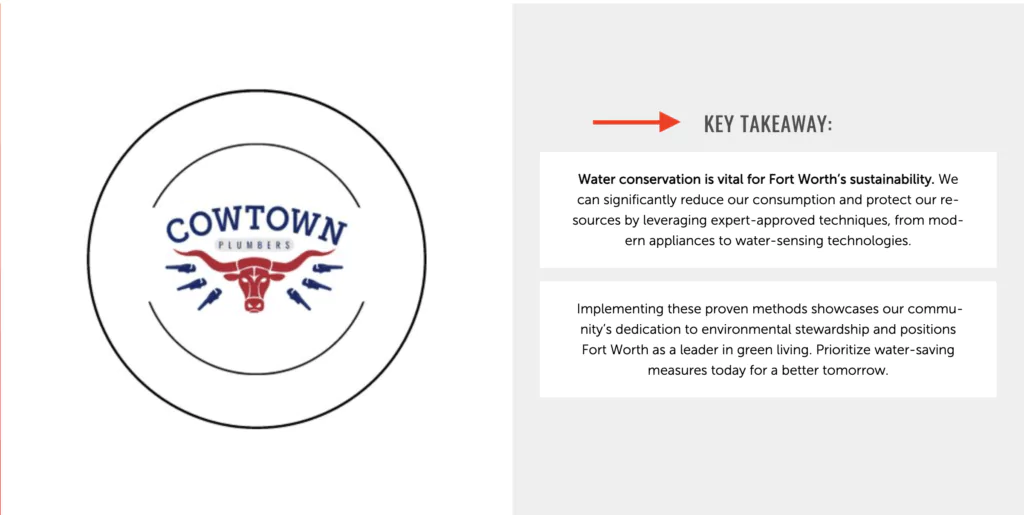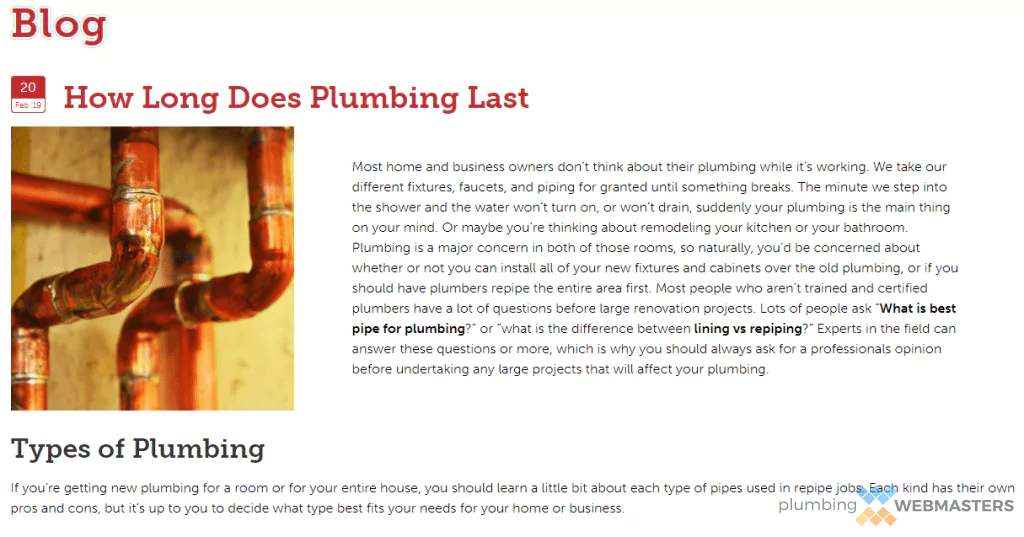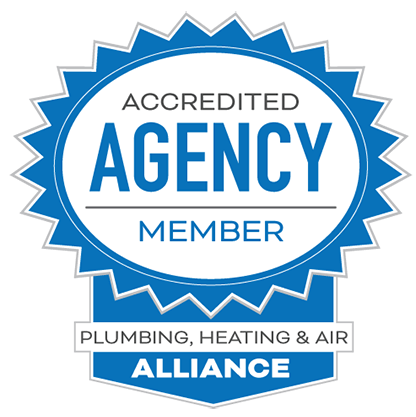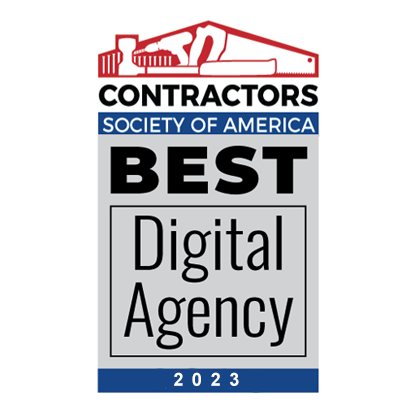Before the emergence of ChatGPT, brainstorming blog topics for your plumbing website was a challenge.
Today, AI and large language models can produce thousands of potential blog topics in mere seconds.
Unfortunately, haphazardly publishing posts based on these AI-generated topics can harm your website’s rankings on Google.

Nolen’s Key Takeaway
When I first started Plumbing Webmasters back in 2011, blog posts would rank easily on Google. Today, in 2025, blogging is largely an obsolete SEO tactic.
Plumbing Webmasters performs content writing services for hundreds of plumbers nationwide.
With a decade-plus worth of keyword research data, we can provide a trustworthy list of blog topics that can generate traffic on Google.
However, we strongly urge you to consider other SEO tactics instead.
Based on our internal agency data, we present 102 plumbing blog topics you can use for your website.
We also include the target keyword volume to indicate the post’s potential reach in hopes of boosting your plumbing content in 2025.
You can use these topics for your plumbing company blog to increase traffic, engagement, and rankings, though we strongly recommend utilizing more modern approaches.
Note on Zero-Volume Blog Topics
Although keyword research tools may assign “zero” search volume to a given blog topic, it does not mean that a blog post targeting the query won’t receive any traffic.
In fact, blog topics targeting zero-volume search queries often attract significant traffic from search engines, especially if they provide a unique perspective on a topic that is not currently available on other websites.
Check Out These Plumbing Blog Topics
| Blog Topic | Keyword Volume |
|---|---|
| how to use a plunger | 5,400 |
| clogged toilet fix | 2,400 |
| how to shut off water to house | 2,400 |
| water heater pressure relief valve leaking | 2,400 |
| what to do if your pipes freeze | 2,400 |
| how to fix clogged toilet | 1,900 |
| how to tell if you have hard water | 1,900 |
| no hot water in shower | 1,900 |
| how to fix a clogged sink | 1,600 |
| electric vs gas tankless water heater | 1,300 |
| toilet keeps clogging | 1,300 |
| water main shut off valve at street | 1,300 |
| why is my water heater leaking | 1,300 |
| how long do sump pumps last | 1,000 |
| how to clean shower heads | 1,000 |
| kitchen sink clogged tried everything | 1,000 |
| outside water shut off valve | 1000 |
| how to clean a showerhead | 880 |
| how to clean a showerhead with vinegar | 880 |
| how to clean your shower head | 880 |
| how to tell if your septic tank is full | 880 |
| emergency water shut off | 720 |
| hot water tank pressure relief valve leaking | 720 |
| water main shut off | 720 |
| why is my garbage disposal leaking | 720 |
| why is my tap water cloudy | 720 |
| does reverse osmosis remove minerals | 590 |
| pressure relief valve leaking | 590 |
| does drano damage pipes | 590 |
| how does a grease trap work | 590 |
| how to test sump pump | 480 |
| signs your water heater is going to explode | 480 |
| symptoms of a clogged drain vent pipe | 480 |
| water heater relief valve leaking | 480 |
| what is pex piping | 480 |
| best temperature for water heater | 390 |
| best toilet paper for plumbing | 390 |
| how to flush toilet when water is turned off | 390 |
| no cold water in shower | 390 |
| slab leak symptoms | 390 |
| what causes a faucet to drip | 390 |
| what size hot water heater do i need | 390 |
| what size sump pump do i need | 390 |
| what to do when toilet overflows | 390 |
| where is my water shut off | 390 |
| how to find a water leak in your house | 320 |
| how to stop a toilet from overflowing | 320 |
| where is the main water shut off in my house | 320 |
| why does my bathroom sink smell | 320 |
| what to do if water heater is leaking | 320 |
| what is hydro jetting | 320 |
| how to find main water valve | 260 |
| water pressure drop | 260 |
| does vinegar and baking soda clean drains | 210 |
| emergency water shut off valve | 210 |
| how does water filtration work | 210 |
| how long does cast iron pipe last | 170 |
| how to find water shut off valve outside | 170 |
| how to tell if your toilet is leaking | 170 |
| how to test home water pressure | 170 |
| symptoms of high water pressure in house | 170 |
| do green copper pipes need to be replaced | 140 |
| garbage disposal problems and solutions | 140 |
| bath tub clog | 140 |
| how to find main water shut off | 110 |
| how to fix a smelly garbage disposal | 110 |
| do plumbers do gas lines | 110 |
| common plumbing issues | 90 |
| deodorizing garbage disposal | 90 |
| how often should a toilet be replaced | 90 |
| how to stop overflowing toilet | 90 |
| how to tell if drain field is failing | 90 |
| turn off water at street | 90 |
| do you need a plumber to install a sump pump | 90 |
| how long does a water pressure regulator last | 70 |
| how to fix a leaking hose bib | 70 |
| shower mixing valve problems | 70 |
| toilet water wont go down | 70 |
| what is good water pressure for a well | 70 |
| what type of shower valve do i have | 70 |
| why is my toilet flushing slowly | 70 |
| how to increase water pressure in a house | 50 |
| repiping house on slab | 50 |
| losing water pressure in shower | 40 |
| house water shut off | 30 |
| how to shut off water main at street | 30 |
| what type of pipes are used in new homes | 30 |
| can rose roots damage water pipes | 20 |
| how hard is it to install water heater | 20 |
| how to find the water supply line to the house | 20 |
| how to use a toilet plunger correctly | 20 |
| residential plumbing problems | 20 |
| shower water pressure dropped | 20 |
| slab leak repair options | 20 |
| unexplained puddle of water on floor | 10 |
| how to cover outside pipes for freeze | 70 |
| why isn’t my water working | 70 |
| does hydro jetting remove roots | 20 |
| how long does hydro jetting take | 20 |
| is hydro jetting better than snaking | 20 |
| how often should you hydro jet your sewer line | 10 |
| how to diagnose plumbing problems | 10 |
How Long Should My Blog Posts Be?
The highest-ranking blog posts typically range from 1,000 to 2,000 words in length. However, Google has publicly stated that word count is not a ranking factor.
Furthermore, Google values user experience, and most users want to see an answer immediately after clicking on the search result.
With this in mind, make sure to include a “key takeaway” or “summary” section near the top of your post so that you can provide a concise answer to the fundamental question of the post’s topic.

Where Should I Link My Blog Posts?
Link to the most relevant service page based on the topic.
For example, link to your slab leak repair service page if you are writing a post about slab leak symptoms. This way, you move blog readers through a funnel to becoming a plumbing client.

How Frequently Should I Publish Blog Posts?
Publishing frequency is irrelevant. The goal of blog posts is to increase organic traffic from Google and serve as social media and email marketing content.
Therefore, there’s no set number of posts you should publish per week or month. Instead, try to rank for as many relevant keywords as possible.

Final Thoughts on Plumbing Blog Topics
In its traditional sense, blogging is no longer an effective promotional technique for plumbers. Nobody is going to bookmark your plumbing company blog and check out every newly published post.
However, with the right blog topics, posts can still contribute to topical authority. The key is publishing optimized posts that target a specific keyword and topic.
These posts can rank on Google search results and bring in organic traffic.






